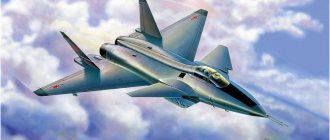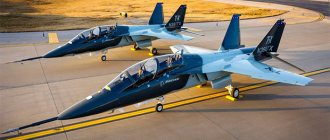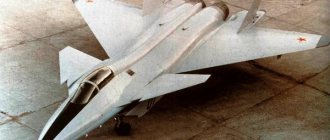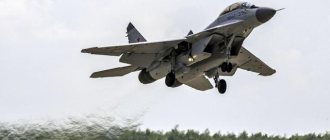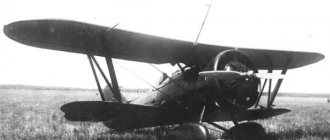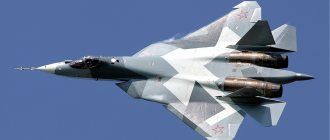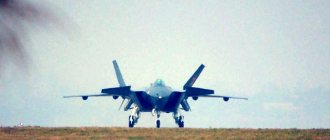PR and Russian trace
It was only recently that they began to divide the entire post-war history of aviation into five generations, and there is still a lot of debate about it.
Quite clear criteria exist only for designating the fifth generation. This is cruising supersonic (the ability to make long flights at speeds exceeding the speed of sound. - Ed.), super-maneuverability (the ability to maintain stability and controllability with a greater deviation from the direction of flight, figuratively speaking - the ability to “fly tail first.” - Ed. .) and a high level of “stealth” (invisibility for detection means, primarily radars. - Ed.). Dig a little further into history and the boundaries become much more blurred. Which generation should we include, for example, the F-111 and F-117? And the Harrier?
And even during work on the ATF (the future XF-22 and XF-23), “stealth” did not appear immediately. At first these were highly maneuverable fighters using only some methods to reduce visibility. Today they would be called, at most, the “four plus” generation.
So generations are an artificially constructed concept that has nothing to do with real aircraft manufacturing. Pure PR. And oddly enough, we were the first to start this “game”. No, not the editorial office of WARHEAD.SU, but the Russian Federation.
Of course, the term “new” or “next generation” was found in the West even in the late 80s. But it began to be widely used only in 1994, after the Russian press first used the “fifth generation” to describe the MFI fighter (the future MiG 1.44). The term quickly took root and migrated overseas.
MiG-1.44. The first aircraft to be called a fifth generation fighter
Now it is used wherever possible, as an indicator of the advancedness of the aircraft being developed.
They also quickly explained where the previous four generations were hiding. And the term spread further - to tanks, ships, submarines and much more.
If you don’t know how to advertise a new weapon, come up with a new generation for it (ideally the fifth)! Even if no one had heard of these generations before.
But progress does not stand still, and the fifth must inevitably be followed by the sixth.
The choice of layout for the promising Boeing Model 988 fighter. This project of the early 90s can be called transitional from the fifth to the sixth generation
Technology demonstrators
The Europeans approached the issue of a new generation in an original way: they abandoned the fifth and immediately moved on to creating the sixth. Dassault nEUROn became a kind of test for new generation technologies. A reconnaissance and strike drone made using stealth technology first saw the sky in 2012. The device is subsonic and can reach a maximum speed of Mach 0.8. The experimental UAV will not go into production, but will allow us to test a number of technologies that will form the basis of real sixth-generation machines. But even if a new generation aircraft is created in Europe, it is naive to believe that it will be able to compete with American fighters. Still, it is quite difficult to step over an entire generation and remain on par with leading manufacturers.
China is currently busy developing fifth-generation fighters J-20 and J-31 and is also not averse to dreaming up the theme of the aircraft of the future. In 2013, the Chinese Lijian stealth strike drone flew, the technologies of which will ensure this very future. Lijian can carry a payload weighing up to 2 tons, and its flight range reaches 4 thousand km. You can be completely confident that Chengdu Aircraft Industry Corporation and Shenyang will soon come close to the appearance of the new aircraft.
Lijian UAV / ©flightglobal.com
Japan has also expressed a desire to acquire a sixth generation. The fighter will be created based on the experience gained from testing the experimental ATD-X device. The development of the sixth generation will be carried out jointly with the Americans. The ATD-X project itself is sometimes called a fifth-generation prototype, but this, as far as can be judged, is incorrect. ATD-X is not a prototype, but a demonstrator of future technologies.
Great Leap Forward
For the first time they thought about creating “sixes” in the USA. Considering the undeniable leadership of Americans in the aircraft industry, this is not surprising. True, they decided to create even more advanced machines not because the fifth generation was outdated.
In the early 90s, it became clear: the “fives” turned out to be very complex machines, and most importantly, expensive. It will be costly even for the United States to saturate the troops with them. At the same time, the Americans are in a unique position - they have no competitors in this area. The Russian Federation has no time for airplanes; China still has decades to develop into advanced machines. The US lead was estimated at at least 20 years.
Of course, both the Navy and the US Air Force had their own sixth generation programs. In the photo: Boeing F/A-XX is a promising carrier-based fighter that should replace the F/A-18. On the right is the unmanned version
Given these advantages, it was possible to try to gain an even greater lead. Do not build the fifth generation en masse, but transfer all funds to create more advanced aircraft. And when, at the beginning of the third decade of the 21st century, other countries finally approach production of their fifth generation, the United States will already have a sixth in the air. And the gap will become insurmountable.
And this is already a machine for the Air Force. Lockheed Martin NGAD (Next Geneation Air Dominance, “new generation air superiority”)
In general, the military liked the idea. Of course, they did not withdraw all the funds in favor of the promising sixes, but they provided some funding for the work.
The first step was to decide what would be new in the sixth generation. A variety of options were proposed: cruising hypersonic (hypersonic is usually called a speed more than five times the speed of sound. - Ed.), optical camouflage and much more.
A sixth generation aircraft with a focus on speed. Lockheed Martin's Vision
In the end, we decided on the main parameters. The main feature of the “sixes” should be the optional presence of a pilot. The aircraft were supposed to be created with the expectation that a significant part of the aircraft would be unmanned. And each manned one will become the leader of a small flock of unmanned fellows. Super-maneuverability will extend to all flight modes, including at maximum speeds. The plane will receive laser and hypersonic weapons, and the ability to repair minor damage right in the air. Well, the standard “gentleman’s kit”: more stealth, better electronics and radars, more advanced communications and data transfer.
The use of laser weapons against ground targets from an unmanned NGAD version from Boeing
Sixth-generation manned fighters lead unmanned versions of themselves into battle
The master of the sky is the 6th generation fighter T-60 “Dove”. Secret project based on the Su-57
Projects for the 6th generation of fighters have been in development by military engineers and designers for a long time. Work on their creation is carried out in secret. Just as it once was with 4th and then 5th generation fighters. The modern world and military technologies are rapidly moving forward, and the military is now in search of fundamentally new solutions and capabilities for Russian combat fighters.
It is known that the first steps and developments in the direction of the T-60 “Dove” project were made back in 1980 in the USSR. After the collapse of the Soviet Union, many projects were frozen. However, these days we can observe an active process of reactivation and further development of Soviet military projects. The most recent example of this is the creation and introduction into service of the Russian Aerospace Forces of the 5th generation fighter Su-57, the project of which was developed back in the days of the Soviet Union.
The secret T-60 “Golub” project based on the Su-57 is intended to replace or supplement and enhance the combat power of Russian 4th and 5th generation fighters. The project received the name “Dove” due to the external similarity in shape and color of the aircraft fuselage with this bird. The drawing of the T-60 fighter project also resembles sketches from science fiction films and computer games of the end of the last century - like a small and very high-speed spaceship. And judging by the supposed characteristics of this aircraft, all this seems to be true. Currently, the main point is to create fundamentally new fighters that can move at great speed under the control of a pilot and/or in unmanned mode. Also, new fighters should be able to carry out combat missions in nearby space.
According to the characteristics, the estimated flight speed of the T-60 is over 2500 km/h. Subsequently, it is planned to increase it to 6000 km/h by creating an engine adapted to these flight conditions. Flight altitude is more than 20 km, payload is more than 20 tons. The length of the fighter is 38 meters, the wingspan is 35 meters. In technical terms, it will be equipped with hypersonic missiles and the most advanced electronic warfare systems.
Flight tests of this fighter can be expected closer to 2030. Fantastic? It sounds really fantastic: a fighter that flies at enormous speeds and is capable of performing missions in near space is a real master of the sky. But only at the end of the last century, people were filming science fiction about robots and automated technology, which today has already been introduced in many countries. Therefore, whether it’s true or not, whether it will be possible to bring the project to fruition or not, we’ll find out over time and most likely we won’t have to wait long for an answer to this question.
Don't forget to share the news on your social media pages below.
